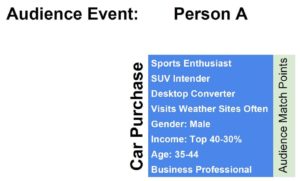A Walkthrough of Establishing Effective Audiences
Data – It’s not about knowing what a single person will do in each scenario, but instead having a strong inclination as to what a group of people will do in most scenarios.
- Unknown Quote
Audiences come in all shapes and sizes. Slicing and dicing similarities and points of interests of an audience is extremely helpful when looking at ways to expand an audience and to target an audience with more efficiency. Audience modelling is a powerful tool in a marketer and business’s playbook and can be leveraged across platforms.
Knowing your buyer, or target market, is one of the most important things in a marketing strategy. If you understand that market, placements and messaging follow. Creating and continuously developing audience models allows for getting a continuously better understanding of that buyer that keeps your business’s doors open. Let’s explore some FAQ’s around Audience Modelling and Lookalike Audience Generation.
What Platforms Do Lookalike Audiences Apply To?
The platforms we utilize are some of the more standard digital platforms for first party audience creation and activation, including Google, Facebook/Instagram, Snapchat, Microsoft/LinkedIn and other popular DSPs and OTT platforms. Each platform matches and lookalike audiences a little differently but arrive at nearly the same end goal. Aside from the platforms, DMP’s provide a business with a cross-platform approach to audience modelling.
What Kind Of Audiences Do We Look For?
When creating audiences, we are looking at behaviors that tell us something we can act on. We’re looking past the just general visitor lookalike, rather we’re looking for impactful events or actions. Let’s say you’re website is about content consumption, then the lookalikes we’re look for are based off of an audience that spends an x amount of time on the website, visits multiple article pages, downloads a piece of content, or subscribes. If your a business that is looking to sell something, we’ll take a look at purchase events and build off of that in order to make sure our audience is built off of in-market behaviors at the foundation.
What Kind of Data Sources Can Be Used For Audience Modelling?
There are are all sorts of audience sources that can be utilized, including Analytics Platforms, Website Cookies, etc. You can also use email addresses, mailing addresses and more. Offline events such as sales information and CRM’s provide just as much information on your customers to build off of.
What Makes A Better Audience Model?
The larger and more targeted an audience is, the better. Imagine a spectrum with a defined left point of either 0 or 1 people, and to the right is infinite. That starting point to the left is an exact match on similarities, because it’s not matched against anyone. An audience based off of that would be really, anything that person was interested in. Just like anecdotal research, this wouldn’t have much of a basis. The further right you go, the more similarities you can trace. Look at these examples below:
A. Single Person Audience Model:

This audience does not really tell us much about PEOPLE buying a car. This tells us what one person did and if you would model an audience based off of this one off purchase, you’d potentially be matching every known character trait. The example above would just try to match any business professional, any person age 35-44, SUV intenders, and so on.
B. Medium Sized Audience Model:

With additional people now in the audience pool, there are more details to identify similarities and then your chances of matching this against a future audience set that would be likely to trigger that event increase.
C. Large Sized Audience Model:
Looking at the larger audience model, there are even more layers of people’s behaviors that are available to match. This narrows the expanded targeting more towards what we know of the people converting for a car purchase. At the end of the day, this is what we are looking for and it takes the guesswork out of target market expansion and exploration.
Perhaps seeing the above diagrams from a small audience to large doesn’t necessarily show you what you miss, but looking at the reverse may help you understand. In theLarge Sized Audience Model section, Person A is a Business Professional. This would have been one of the match points in the first audience, basing it only off of a single person which when we expand the audience appears to not even be relevant. There is always a chance of this happening when you sample an audience – applying an audience model to an entire population is not just impossible but also irrelevant (no need to expand to a Car Purchase audience, you already know they bought!).
Corkboard Concepts for instance sees hundreds of automotive converters for each of our automotive clients each month and when those are added together, we’re seeing thousands and thousands of auto converters across the board. We take the 1:1 audience remarketing approach for our individual clients but leverage the audience learning across all clients in the same industry to get a better model of that “Car Buyer”.
How Do Campaigns Benefit From Targeting With Defined Lookalike Audiences?
Campaign benefit from Lookalike Audiences in many ways. We see a range of benefits from enhanced website behavior and conversions. With standard optimization practices and conversion based campaigns, we see this behavior over time anyways but with Lookalike Audience Modelling, it allows us to expand our target audience while driving efficiencies. Other targeting optimization practices narrow an audience over time.
How Do You Sync Audience Models With Other Marketing Tactics?
Lookalike audiences are meant to be layered and used as prioritizations in targeting but aside from leveraging Audience Profiles with other targeting, we also sync it with Conversion Optimized campaigns. Since we’re building these audiences off of event triggers, we have those triggers to also optimize the campaigns to, which aligns with business goals and also inherently makes our audiences perpetually better.
Does Audience Modelling Not Work In Certain Industries?
Outside of protected categories (i.e. healthcare), there aren’t really any bad industries to model audiences off of. Certainly, industries that tend to attract a larger share of the population benefit from the scale of their industry but even more niche industries can benefit from audience modelling, and I would even be tempted to say more so.
We’ll leave you with one final question…






